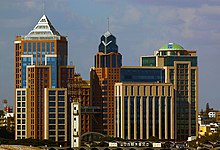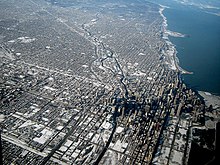Central business district
This article needs additional citations for verification. (February 2007) |

A central business district (or CBD, also called a central activities district and in North America a "downtown") is the commercial and often geographic heart of a city. In Algeria, Australia, Hong Kong , Kenya, New Zealand, Philippines, Singapore and South Africa, the phrase is commonly used,[citation needed] and is often colloquially abbreviated to "CBD".
Definition
Overview

The CBD is the central district of a city, usually typified by a concentration of retail and commercial buildings.[1]
The term city centre/center is similar to CBD in that both serve the same purpose for the city, and both are seen by a higher-than-usual urban density as well as the often having the tallest buildings in a city. City centre differs from downtown in that the latter can be geographically located anywhere in a city, while a city centre is generally located near the geographic heart of the city. London arguably has three city centres, the City of London, the medieval City of Westminster and Canary Wharf.[citation needed]. Mexico City also has more than one city center: Historic centre of Mexico city, the colomial; Paseo de la Reforma - Polanco (Mexico) the mid-late XX century CBD, and Santa Fe, the new CBD.
The shape and type of a CBD or downtown almost always closely reflect the city's history. Cities with maximum building height restrictions often have a separate historic section quite apart from the financial and administrative district. In cities that grew up suddenly and more recently, such as those in the western half of North America, a single central area will often contain all the tallest buildings. It has been said that downtowns (as understood in North America) are therefore a separate phenomenon.[2]
Central business districts usually have very small resident populations. For example, the population of the City of London declined from over 200,000 in 1700 to less than 10,000 today. In some instances, however (and particularly in large Australian cities), CBD populations are increasing as younger professional and business workers move into city centre apartments.
Characteristics
The CBD is where people go in the centre of towns and cities .
Characteristics:
- It contains main public buildings such as libraries, churches, stations and town halls.
- It contains specialist shops and branches of major department stores such as Macy's.
- It contains social amenities such as cinema halls, clubs and theatres.
- Although buildings are open to the public there is no area for housing. However, there may be hotels.
- Industry is not present.
- It contains offices and other professional buildings.
- These buildings tend to be taller than other buildings in the city because it is cheaper to buy a small plot of land and build upwards than buying a huge plot of land and only building one or two floors.
- Pedestrian levels are particularly high and parking restrictions are greatest.
- Geographical center of the settlement.
- It is likely to contain a region with the greatest land value.
- Transportation such as trains, underground metro services and park and ride services
- High concentration of traffic.
- High use of public transportation.
- High employment rate.
Usage




The alternative term city centre is used in Britain and Ireland, and also in some urban areas of British-influenced countries, such as the Commonwealth and Mainland China (Chinese: 市中心). In the United Kingdom, Australia, South Africa, Canada and New Zealand, the term is often just shortened to "city", as in "going to the city". This term is also used in the New York City area in the same manner, using the term the city to mean Manhattan. Similarly, San Francisco is referred to as "the City" in the Bay Area. One exception is in London where "the City" specifically refers to the City of London financial district rather than to any other part of central London. In many parts of the world, including the UK, Australia, New Zealand, South Africa, India (especially Mumbai, where CBD is also known as "Townside") and Ireland, it is often also referred to as "town" ("going (in)to town", "going up town", or "going down town").
Argentina
The Buenos Aires central business district (CBD and also referred to as the City Porteña), is the main commercial centre of Buenos Aires, the capital of Argentina. The actual area was the point of first European settlement. Its north-south axis runs from Monserrat in the north to Retiro railway station in the south. Its east-west axis runs from Buenos Aires Ecological Reserve and Puerto Madero.
The district is the financial, commercial, and cultural hub of Argentina. Its port is one of the busiest in South America; navigable rivers by way of the Río de la Plata connect the port to north-east Argentina, Brazil, Uruguay and Paraguay. As a result it serves as the distribution hub for a vast area of the south-eastern region of the South American continent. Tax collection related to the port has caused many political problems in the past. Measured in GDP, the economy of Buenos Aires was the 13th largest economy among the world's cities in 2005 at US$245 billion in purchasing power parity,[1] which, based on the population of that year,[2] translates into US$19,500 per capita. The Buenos Aires Human Development Index (0.923 in 1998) is likewise high by international standards.[3]
The city's services sector is diversified and well-developed by international standards and accounts for 78% of its economy (compared to 58% for all of Argentina's);[4] advertising, in particular, plays a prominent role in the export of services at home and abroad. Manufacturing is, nevertheless, still prominent in the city's economy (17%) and, concentrated mainly in the southside, it benefits as much from high local purchasing power and a large local supply of skilled labor as it does from its relationship to massive agriculture and industry just outside the city limits themselves.
Brazil
The São Paulo central business district, is the Avenida Paulista, in the region close to the city center, which is also a financial center, but has the same influence of decades ago. However, there are other central outside the geographical core, as the districts of Santo Amaro and Itaim Bibi, more precisely the regions of Brooklyn and Juscelino Kubitschek Avenues, Rebouças and Faria Lima, in south-central city, which are characterized by intense vertical, and the presence of luxury hotels and multinational companies.
The biggest financial center in Brazil and one of the biggest finacional centers in the world, São Paulo's economy is going through a deep transformation. Once a city with a strong industrial character, São Paulo's economy has become increasingly based on the tertiary sector, focusing on services and businesses for the country. The city is also unique among Brazilian cities for its large number of foreign corporations. Many analysts point to São Paulo as an important global city, even though this assignment can be criticized considering its serious problems of social exclusion and spacial segregation. Although being the most important financial centre of the country, São Paulo also presents a high degree of informality in its economy.
Germany
In Germany the terms Innenstadt or Stadtmitte may be used to describe the central business district. Both terms can be literally translated to mean "inner-city" and "city-centre". While most German cities only have one central business district, Berlin has three. Due to Berlin's history of division during the Cold War, the city contains central business districts both in West Kurfürstendamm and East Berlin (Alexanderplatz), as well as a newly built business center near the Potsdamer Platz. The city's historic centre, location of the Reichstag building as well as the Brandenburg gate and most federal ministries was largely abandoned as the Berlin Wall cut through it. Only after the re-unification with the construction of numerous shopping centers, government ministries, embassies, office buildings and entertainment venues, was the area revived.
South Africa
South African cities like Cape Town and Johannesburg have 3 CBD`s while cities like Durban and Port Elizabeth only have one. Cape Town is known to have South Africas most iconic skyline and CBD.
Francophone world
In France and French-speaking regions, the most common term for a city's center is centre-ville (town center). In many of the largest francophone cities, however, centre-ville refers to an historic district rather than a business district, or it may not be used at all.
In Paris, the main business district is distant from the geographical centre of the city in La Défense, on the western edge of the boundaries of the Paris commune (municipality). Brussels' historic centre is bounded by the inner ring road. However, the financial and administrative district is the Leopold Quarter. Montreal's historic core, Old Montreal, is no longer the financial district, which is now Downtown Montreal.
Some francophone cities use centre-ville to refer to the CBD. In Beirut, for example, although the CBD is officially called Beirut Central District, the Lebanese use the French term centre-ville.
United States and Canada

In the United States, central business districts are often referred to as "downtown" (even if there is no "uptown"). In most cities the downtown area will be home to the financial district, but usually contains entertainment and retail of some kind as well. The downtown areas of many cities, such as Chicago and Houston, are also home to large sports and convention venues. Historic sections of a central business district may be referred to as "old town", while decaying parts of the center city are commonly referred to as the "inner city". The term inner city is sometimes not used literally but rather evocatively, applying a negative connotation and referring paradoxically to peripheral areas blighted during a mass exodus of middle class residents.
Some cities in the United States, such as Minneapolis, and Dallas, Texas, have mixed use districts known as "uptown" in addition to the primary downtown core areas. In some cities, such as Charlotte, Chicago, and Oklahoma City, "uptown" is instead the historic name for a separate business center or neighborhood. Philadelphia and Wilmington, Delaware use the term center city instead of downtown for their central business districts. Some cities, such as Toronto, regard as many as four business districts as being central. In other cities, like Los Angeles and Indianapolis, the city core is simply known as "downtown."
By broad definition, New York City's CBD comprises the whole southern half or third of Manhattan island. Narrow definitions include only a square mile or two (3-5 km²) of Midtown as central, with the lowest tenth of the island, including the Financial District, being a secondary business district rather than the central one. Similar narrow and broad definitions are applied to the Chicago's downtown high rise districts.
See also
References
- ^ Central Business District (from scalloway.org.uk website)
- ^ Reviving American downtowns - The Economist, Thursday 1 March 2007
